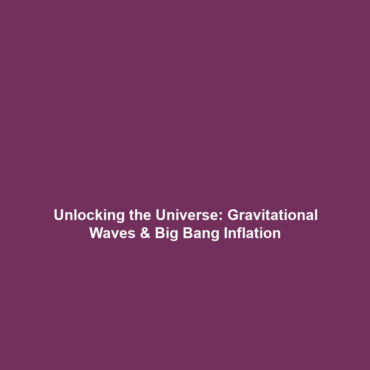How Gravitational Waves Might Reveal Information About Inflation After the Big Bang
Introduction
Gravitational waves, ripples in spacetime produced by accelerating masses, are revolutionizing our understanding of the universe. Their detection opens a critical window into the early moments of cosmic evolution, specifically the period of inflation that occurred after the Big Bang. This groundbreaking area of research promises to shed light on the fundamental dynamics of the universe, potentially revealing key insights into cosmic inflation—a rapid expansion phase that shaped the cosmos as we know it. Understanding how gravitational waves can elucidate these phenomena is significant for both astrophysics and the broader field of cosmology.
Key Concepts
To understand the implications of gravitational waves on the study of inflation after the Big Bang, it is essential to grasp several core concepts:
The Nature of Gravitational Waves
Gravitational waves, detected for the first time by LIGO in 2015, are created by massive objects such as merging black holes or neutron stars. Their ability to traverse vast distances without degrading makes them powerful tools for cosmic observation.
Cosmic Inflation
Cosmic inflation refers to a theoretical exponential expansion of the universe during its first few moments. This event is posited to have occurred within a fraction of a second after the Big Bang and is believed to have smoothed out any irregularities in the early universe, leading to the large-scale structure we observe today.
Connecting Gravitational Waves and Inflation
Recent theoretical advancements suggest that gravitational waves generated during inflation can create a distinct background noise of waves that may be detectable today. By studying these primordial gravitational waves, scientists can gather evidence about inflationary processes.
Applications and Real-World Uses
The exploration of how gravitational waves can provide insights into early cosmic events holds several practical applications:
- Data Analysis: Advanced data processing techniques designed to analyze gravitational wave signals contribute to enhancements in signal detection methodologies.
- Astrophysical Models: Insights gained from gravitational waves inform the development of cosmological models that attempt to explain the universe’s formation and structure.
- Interdisciplinary Research: Research into gravitational waves fosters collaboration across physics, engineering, and astronomy, leading to innovations in various fields.
Current Challenges
Despite the promising potential of gravitational waves in informing our understanding of cosmic inflation, several challenges persist:
- Signal Detection: Distinguishing between background noise and genuine gravitational wave signals remains a substantial hurdle in observational astronomy.
- Model Validation: Current models of inflation need to be validated through experimental data, which is an ongoing area of research.
- Technological Limitations: The sensitivity of detectors must improve to identify weak gravitational signals associated with inflation.
Future Research and Innovations
The future of research into gravitational waves and cosmic inflation encompasses exciting possibilities:
- Next-Gen Detectors: Upcoming gravitational wave observatories, such as the “Cosmic Explorer” and “Einstein Telescope,” aim to enhance sensitivity and broaden detection capabilities.
- Cross-Disciplinary Innovations: Advances in materials science may lead to improved detector technology, making it easier to capture faint signals.
- Theoretical Developments: Ongoing theoretical work aims to refine models of inflation, potentially leading to new predictions that can be tested with gravitational wave observations.
Conclusion
In summary, the study of gravitational waves offers profound insights into inflation after the Big Bang, providing a means to investigate one of the universe’s most enigmatic periods. Continued research in this field is pivotal for advancing our understanding of cosmology and the fundamental principles governing the universe. For those interested in further reading, explore topics such as cosmic inflation and gravitational wave detection technologies.


